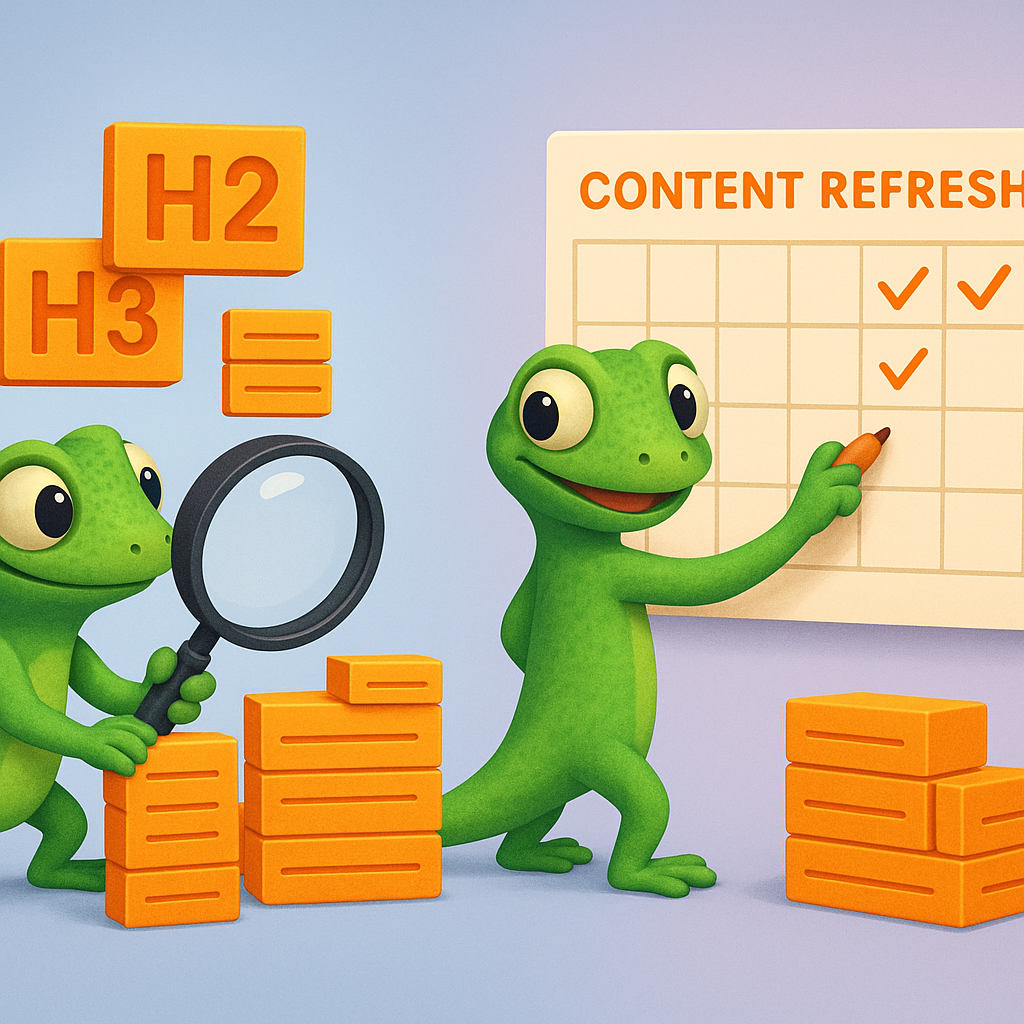What is SEO writing? Content explained for marketing leaders
SEO writing is a strategic content creation discipline that integrates keyword targeting, user intent alignment, and technical optimization to drive organic search rankings and conversions. Far from being just “writing with keywords,” modern SEO content requires a sophisticated understanding of search algorithms, user behavior, and content structure to succeed in competitive SERPs.
Core components of effective SEO writing
Keyword targeting with strategic intent
Successful SEO content begins with identifying high-intent keywords that align with your business objectives. Unlike the outdated practice of stuffing content with keywords, modern SEO writing maintains a strategic density of 1-2% while focusing on:
- Long-tail keywords with specific user intent (e.g., “SEO content writing strategies for B2B” vs. “SEO writing”)
- Low-hanging keyword opportunities with business potential identified through tools like free keyword clustering tool or Google’s “People Also Ask” section
- Semantic relationships between terms to build topical authority
According to SEO data, 20% of content drives 80% of organic traffic, highlighting the importance of strategic keyword selection rather than volume alone. This “80/20 rule” underscores why quality and relevance trump quantity in modern SEO strategy.
Search intent alignment
Google’s algorithms have evolved to prioritize content that satisfies user intent over simple keyword matching. Effective SEO writing addresses the specific purpose behind searches:
- Informational intent: Educational content answering specific questions
- Navigational intent: Content helping users find specific resources
- Transactional intent: Content facilitating purchases or conversions
- Commercial investigation: Content supporting product research and comparison
Content that misaligns with search intent performs poorly regardless of keyword optimization. For example, a transactional page competing for informational keywords will struggle to rank, resulting in wasted resources and missed opportunities. Search intent must be the foundation of your content strategy—not an afterthought.
Content structure optimization
Technical structure significantly impacts both user experience and crawlability:
- Header hierarchy: Implement H1-H6 tags to create logical content structure and signal topic importance
- Content chunking: Break content into scannable sections with short paragraphs and bullet points
- Internal linking: Connect related content to establish topical authority and improve site architecture
- Schema markup: Implement schema structured data markup for enhanced SERP features like rich snippets, knowledge panels, and FAQ sections
Interestingly, 7.4% of top 10 ranking pages lack title tags, and Google rewrites 76% of titles that don’t align with content or search intent—highlighting the importance of coherent content structure. When your content structure aligns with both user expectations and search engine parsing capabilities, you create a dual-optimization that drives performance.
Advanced SEO writing tactics
Semantic SEO and entity-based content
Modern search algorithms evaluate content based on semantic relationships between topics rather than exact keyword matches. Advanced SEO writing leverages:

- Topic clusters: Group related keywords using a free keyword grouping tool to dominate SERPs for broad topics
- LSI keywords: Incorporate semantically related terms (e.g., including “conversion rates” when writing about “email marketing”)
- Entity recognition: Align content with Google’s Knowledge Graph by defining key concepts and their relationships
This approach mirrors how Google’s NLP (Natural Language Processing) algorithms understand content contextually. Rather than viewing your content as isolated pieces, these algorithms assess how well you cover a topic’s ecosystem of related concepts, making semantic connections crucial for ranking authority.
Content freshness signals
Content freshness directly impacts rankings, particularly for topics with evolving information:

- Regular updates: Refresh high-performing content with new data, examples, and insights
- Publishing cadence: Maintain consistent publishing schedules using content calendar tools
- Historical optimization: HubSpot increased traffic by 106% by updating just 14 high-performing blog posts
This HubSpot case study demonstrates a powerful efficiency principle: strategic content refreshes often yield higher ROI than creating new content from scratch. By identifying your content assets with the highest potential and systematically updating them, you can multiply organic traffic without proportionally increasing production costs.
Collaborative content development
Complex SEO content creation requires efficient collaboration across specialists:
- Centralized workflows: Implement content collaboration software to streamline production between writers, editors, SEO specialists, and subject matter experts
- Editorial calendars: Organize content production with downloadable content calendar templates that align publication schedules with seasonal trends and business objectives
- AI-assisted writing: Leverage tools like website content generator for drafting while maintaining human oversight for strategic nuance and brand voice
The most successful SEO content teams operate like well-oiled machines, with clear processes that minimize bottlenecks while maximizing each specialist’s contribution to the final product.
Common SEO writing pitfalls to avoid
Keyword cannibalization
Creating multiple pieces targeting identical keywords dilutes ranking potential. Avoid this by:
- Conducting content audits to identify overlap
- Consolidating similar content into comprehensive resources
- Using a hierarchical topic structure to differentiate related content
Keyword cannibalization is particularly insidious because it creates internal competition where your own content fights against itself for rankings. Many marketing leaders overlook this issue, focusing on creating more content rather than strategically organizing their existing portfolio.
Technical optimization neglect
Content quality alone won’t guarantee rankings without technical optimization:
- Optimize Core Web Vitals (LCP, FID, CLS) for better user experience signals
- Ensure mobile responsiveness for all content
- Implement proper meta tags and structured data
Consider this: you wouldn’t build a premium store in a location with poor roads and no signage. Similarly, even exceptional content struggles to perform when technical foundations are weak. The most successful SEO strategies balance content quality with technical excellence.
Outdated content strategies
“Basic SEO techniques no longer deliver results; deeper, specialized content is required to stand out.” Avoid:
- Shallow content covering topics superficially
- Neglecting to update older content with fresh information
- Ignoring search intent signals in your analytics
The competitive landscape has evolved dramatically. Where once a 500-word blog post might rank well, today’s standards demand comprehensive coverage, original insights, and exceptional user experience. Marketing leaders must recognize this shift and adjust their content depth and quality accordingly.
Measuring SEO writing effectiveness
Effective SEO content should be evaluated based on:
- Organic traffic growth
- Keyword ranking improvements
- Engagement metrics (time on page, bounce rate)
- Conversion performance
- Backlink acquisition
Use tools like Google Search Console and an seo roi calculator to quantify the business impact of your SEO content efforts. The most valuable metrics connect content performance directly to business outcomes—views and rankings matter, but conversions and revenue are the ultimate success indicators.
TL;DR
SEO writing combines strategic keyword targeting, search intent alignment, and technical optimization to drive organic rankings and conversions. Successful implementation requires moving beyond keyword stuffing to create semantically rich, well-structured content that satisfies user intent. Avoid common pitfalls like keyword cannibalization and outdated tactics by staying current with seo content training and leveraging AI tools like ContentGecko to scale production while maintaining quality. With 68% of trackable web traffic originating from search engines, mastering SEO writing remains a critical skill for marketing leaders seeking sustainable organic growth.
